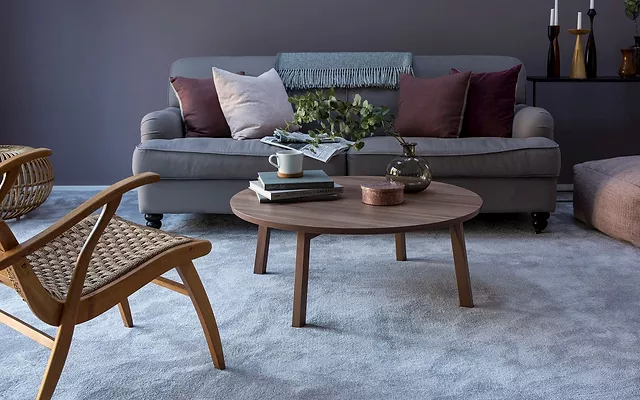All about carpets
Carpets have been around for centuries. To this day they remain one of the primary flooring options and have witnessed considerable innovation when it comes to material, design, and quality. Four main elements define the appearance and the feel of a carpet:
- The type of fibre.
- The type of Pile.
- Grade.
- Underlayment or Backing.
What type of fibres are used for carpet manufacturing?
Carpet fibres form the main body of the carpet. Carpets Wigan are stitched from natural fibres or synthetic fibres while some may have a mix of both. Moreover, different carpet types may have fibres of different thicknesses. This is done by spinning together various strands to form a single strand or ply. The higher the number of ply, the higher will be the carpet thickness.
What is meant by Carpet Pile?
Pile is the arrangement of fibres in a given carpet. A carpet pile has the greatest influence on the look and performance of a carpet. If fibres are arranged in the shape of loops, it is called a loop pile carpet.
An example is a Berber carpet. Carpets with dense and short piles are considered best for crowded places as they are resistant to compression. Longer piles offer a much softer feeling. There are countless types of piles when it comes to carpets.
What is meant by Carpet Grade?
Carpet grade refers to carpet quality. The quality of a carpet is determined by: the quality of construction, face weight, fibre, face weight, and construction. The grade is a measure of the life of carpets.
However, grading is carried out by the manufacturers themselves and there is no standard system for them. Face weight is the amount of fibre/yarn used in manufacturing the carpet. The higher the face weight, the better the quality of the carpet.
What is meant by Carpet Backing?
Carpet backing usually consists of two parts: Primary backing and secondary backing. The former is the part where the fibres attach while the latter protects your carpet padding from the floor. There are numerous types of backings and they can be of natural fibres or manmade.
Most common carpet fibres
Nylon
Nylon carpets can be found in every other home. When it comes to manmade fibres, nylon remains one of the cheapest and most abundant raw materials. Its highly durable, attractive, and affordable.
It remains unaffected from mildew and mold, making it the best carpet for your basement. The quality of nylon fibres may vary from carpet to carpet. The prices of nylon carpets Wigan can vary from very low to very high.

Polyester
Polyester is another manmade fibre. It has many similarities with nylon but is relatively cheaper. It is highly resistant to stains and moisture. It lasts longer than many other raw materials. nylon. When in the form of a thick pile, it can be surprisingly soft. It is less resistant to compression when compared to nylon.
Cotton
For the ultra-soft experience, hardly anything will match cotton. Moreover, it is completely natural and therefore carpets made from cotton are usually pretty expensive. They are easy to clean but it does not fare well when it comes to stains. It requires high maintenance. It is however highly suitable for rooms that do not get a lot of traffic such as your master bedroom.
Wool
Woollen carpets are famous around the world for their plush soft feeling and their exotic appearance. Woollen Carpets Wigan are quite strong and long-lasting. Contrary to popular belief, they are relatively resistant to stains and are easy to clean. Above all, the feeling of a woollen carpet under your feet is unmatched. They are relatively expensive and require extra care.
Other fibres used for manufacturing carpets
- Sisal: Natural fibres produced from the Sisal plant.
- Triexta: Manmade fibre containing corn
- Olefin: Synthetic/manmade fibre prepared from Polypropylene.
Remembers, carpet material will influence the look but fitting is also important. Get the best Carpet Fitters Chorley for a perfect fit.
Carpet Piles Types
Three types of carpet piles are most common:
- Cut Pile: Yarn is cut into pieces of specific height and then twisted from tufts, resulting in a highly soft and luxurious carpet.
- They can be subdivided into the low cut and high cut. Some examples include plush carpets, Saxony carpet, and Frieze carpets.
- Loop Pile: Contrary to the cut pile, in a loop pile carpet fibres are connected twice to the backing, forming loops instead of tufts.
- They do not offer the same luxurious look like the cut pile but are highly durable and do not require much maintenance. Some variations include the Berber carpet and the multi-level loop carpet.
- Cut-and-Loop: As the name suggests they are a combination of both loop and cut fibres. This is done when a design has to be created on the carpet so that the difference in texture is notable.
Carpet Grading
Carpet grades reflect more on how they should be used than the quality. They provide you with an estimate of the durability, lifespan, and quality of different carpets.
Low-Grade: Often found in motels and rental properties. They are not designed for a long life but are highly affordable and lightweight.
Medium-Grade: They last longer than low-grade carpets and are relatively heavier. They can also cost twice as much as low-grade versions.
High-Grade Carpet: These are the longest-lasting types of carpets, at around twelve to twenty years. High-grade carpets are very heavy and are made from good, quality fibres, like wool. They can cost three times the amount of a medium-grade carpet.
Carpet Backing
Carpet backing is not the same as carpet padding. Backing refers to the carpet base and usually is in two layers as we mentioned before. The usual materials used for this purpose include polyurethane, soft plastic, and Jute.













